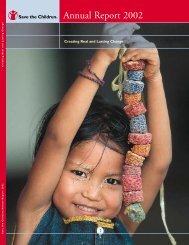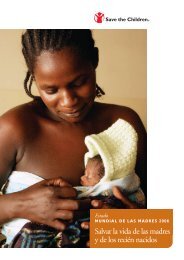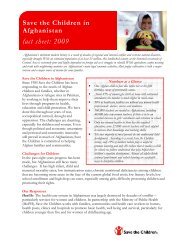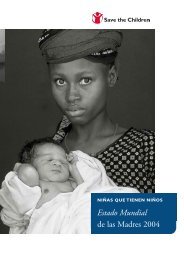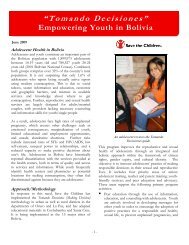The Power and Promise of Girls' Education - Save the Children
The Power and Promise of Girls' Education - Save the Children
The Power and Promise of Girls' Education - Save the Children
Create successful ePaper yourself
Turn your PDF publications into a flip-book with our unique Google optimized e-Paper software.
Girls’ <strong>Education</strong><br />
Progress Report<br />
<strong>Save</strong> <strong>the</strong> <strong>Children</strong> introduces a first-ever Girls’ <strong>Education</strong> Progress Report* comparing 71 developing<br />
countries on gains in girls’ education. None <strong>of</strong> <strong>the</strong>se countries are wealthy, but <strong>the</strong> successful ones<br />
have recognized <strong>the</strong> benefits that accrue to society when girls are educated. <strong>The</strong>y have also found<br />
ways to ensure that both girls <strong>and</strong> boys have an equal chance to attend school <strong>and</strong> succeed in<br />
school. (For <strong>the</strong> complete Girls’ <strong>Education</strong> Progress Report, with data for 71 developing countries, see Appendix A.)<br />
<strong>The</strong> good news: Many developing countries are moving<br />
in <strong>the</strong> right direction in terms <strong>of</strong> girls’ education. <strong>The</strong>re<br />
is no “one-size-fits-all” solution for narrowing <strong>the</strong> gender<br />
gap <strong>and</strong> promoting equality in education, but a number <strong>of</strong><br />
countries have made breakthroughs that have improved<br />
girls’ educational access <strong>and</strong> <strong>the</strong>ir performance in school.<br />
• Bolivia, <strong>the</strong> top-ranked country in terms <strong>of</strong> progress,<br />
succeeded in getting 30 percent more children to<br />
advance to <strong>the</strong> fifth grade between 1990 <strong>and</strong> 2000.<br />
<strong>The</strong>re is almost an equal number <strong>of</strong> girls <strong>and</strong> boys in<br />
primary school compared to 1990, when girls were 10<br />
percent less likely than boys to attend school. Bolivia<br />
enacted an <strong>Education</strong> Reform Law in 1995 that has<br />
led to significant advances. <strong>The</strong>re has also been<br />
improvement in <strong>the</strong> quality <strong>of</strong> education for girls due<br />
to <strong>the</strong> introduction <strong>of</strong> new curricula, improved teacher<br />
training <strong>and</strong> better learning materials in <strong>the</strong> classrooms. 42<br />
(See pages 29-30 for more about what’s working in Bolivia.)<br />
• Kenya, <strong>the</strong> second-ranked country, has almost as<br />
many girls as boys enrolled in primary school, <strong>and</strong><br />
has gone from a girls’ gross primary enrollment<br />
ratio** <strong>of</strong> 85 percent in 1990 to 95 percent in 2000.<br />
Nongovernmental organizations (NGOs) in Kenya have<br />
helped reduce many <strong>of</strong> <strong>the</strong> barriers that once kept<br />
girls out <strong>of</strong> school, including lack <strong>of</strong> money, parental<br />
attitudes, harassment by male teachers <strong>and</strong> fellow<br />
students, pregnancy <strong>and</strong> early marriage. In an effort to<br />
build on recent gains, Kenya’s government introduced<br />
free primary education in 2003 <strong>and</strong> is working on<br />
additional reforms to improve access, retention <strong>and</strong><br />
completion rates for girls. 43<br />
Girls’ <strong>Education</strong> Progress Report – 1990 to 2000<br />
“A” for Progress<br />
Making greatest gains<br />
Rank<br />
Developing<br />
Country<br />
1 Bolivia<br />
2 Kenya<br />
3 Cameroon<br />
4 Bangladesh<br />
4 Morocco<br />
6 Namibia<br />
7 Nepal<br />
8 Togo<br />
9 Benin<br />
9 Madagascar<br />
“F” for Progress<br />
Declining due to conflict,<br />
AIDS <strong>and</strong> rapid population<br />
growth<br />
Rank<br />
Developing<br />
Country<br />
60 Djibouti<br />
60 Lesotho<br />
60 Sudan<br />
63 Papua New Guinea<br />
64 Ghana<br />
65 Tanzania<br />
66 Burundi<br />
67 Congo<br />
68 Eritrea<br />
69 Malawi<br />
70 Iraq<br />
71 Rw<strong>and</strong>a<br />
Countries in <strong>the</strong> Top 10 <strong>of</strong> <strong>the</strong> Girls’ <strong>Education</strong> Progress Report<br />
have used a variety <strong>of</strong> strategies to improve female primary<br />
school enrollment rates, equalize <strong>the</strong> ratio <strong>of</strong> girls to boys in<br />
school, <strong>and</strong> increase <strong>the</strong> number <strong>of</strong> children who advance to<br />
grade five. Countries in <strong>the</strong> Bottom 12 performed poorly on<br />
those three indicators, mostly due to armed conflict, refugee<br />
influxes, rapid population growth <strong>and</strong>/or <strong>the</strong> ravages <strong>of</strong><br />
HIV/AIDS. For <strong>the</strong> complete Girls’ <strong>Education</strong> Progress Report, with<br />
data for 71 developing countries <strong>and</strong> <strong>the</strong> research methodology,<br />
see Appendix A.<br />
* Countries were compared against each o<strong>the</strong>r in terms <strong>of</strong> <strong>the</strong>ir performance on a set <strong>of</strong> key indicators related to girls’ education over a 10-year period (1990 to<br />
2000). Those countries that rose most in <strong>the</strong> rankings are described as “making greatest gains.” Those countries that fell most sharply in <strong>the</strong> rankings are described<br />
as “declining due to conflict, AIDS <strong>and</strong> rapid population growth.”<br />
** <strong>The</strong> female gross primary enrollment ratio measures <strong>the</strong> number <strong>of</strong> girls <strong>of</strong> any age who are enrolled in primary school. It includes girls who did not enter school<br />
at <strong>the</strong> appropriate age <strong>and</strong> girls who are not progressing through grades at <strong>the</strong> expected rate. This differs from <strong>the</strong> female net primary enrollment ratio, which<br />
measures <strong>the</strong> number <strong>of</strong> girls <strong>of</strong> primary school age who are enrolled in primary school. <strong>The</strong> net enrollment ratio is more accurate in depicting <strong>the</strong> efficiency <strong>of</strong> <strong>the</strong><br />
school system, however it is not as widely reported by countries.<br />
18<br />
THE POWER AND PROMISE OF GIRLS’ EDUCATION






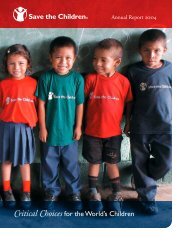
![View full document [PDF 3.39 MB] - PreventionWeb](https://img.yumpu.com/27308954/1/190x245/view-full-document-pdf-339-mb-preventionweb.jpg?quality=85)
